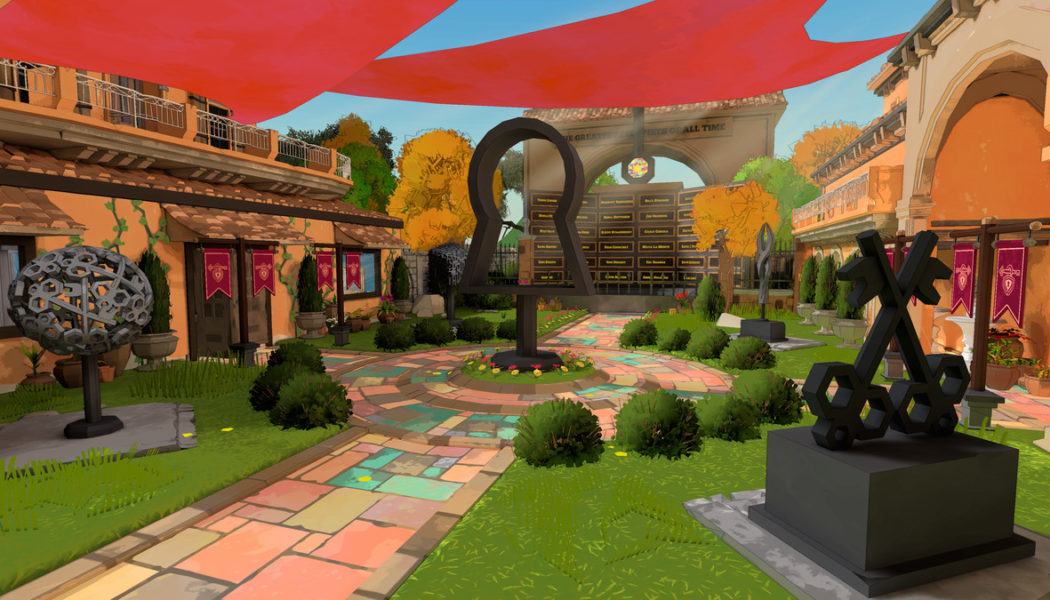I’ve been in the mood for a good puzzle game. No, that’s not accurate enough. If a good puzzle game came to my door and proposed marriage, I would blow up my life and career for it the same way that journalist did for that pharma bro. (But I’d at least have the good sense to take the inevitable L privately.)
I wanted Escape Academy to ruin my life like that, the same way Inscryption did.
And while the escape room puzzle game / visual novel isn’t the equivalent of Tessa Thompson or Tom Hiddleston — or Tessa Thompson and Tom Hiddleston — showing up at my door on bended knee; I can say it’s more like that greasy guy from The Bear cooking an intimate dinner for two in his furniture-less apartment — absolutely incredible but sparse and far too short.
Escape Academy tells the story of a young escape room aficionado and their journey through a clandestine school where the world’s best escape artists hone their skills with a variety of puzzles. Along the way, you get to know the quirky students and professors who call Escape Academy home while solving puzzles to unravel the mysteries of the school.
:no_upscale()/cdn.vox-cdn.com/uploads/chorus_asset/file/23842981/ACR_10.png)
The puzzles of Escape Academy are extremely varied, satisfying every subgroup of the problem-solving section in my brain. There are the typical word and math puzzles, some logic puzzles, and my absolute least favorite — the spatial reasoning puzzle. Escape Academy attempts to recreate the anxiety-laced fun of a physical escape room in a video game. But one of the things I enjoyed the most was that you have to get analog to solve the digital puzzles. It’s a full-body experience that engaged my body in ways video games typically don’t. There wasn’t a puzzle room where I didn’t use a pen and a pad of paper, muttering to myself out loud as I worked through the problems.
Having this kind of physical component to the game was deeply satisfying. It reminded me of one of my all-time favorites, the MS-DOS game Where In The World Is Carmen Sandiego?. To beat the game and capture Carmen, you had to look up the answer to the final question in a real book. The solutions were as simple as finding a word in a specific place on a page, but when I did it, it felt so good — like I had transcended some kind of bridge between a real world and a virtual one. Frantically scribbling notes and possible solutions, drawing maps and spinning them around because I’m awful at spatial puzzles feels like some kind of body alchemy. I put a high premium on that kind of full engagement and focus because my ADHD brain just can’t. Escape Academy, simply, feels good to play.
And when you get a puzzle right on the first try after you were sure the answer you derived could not possibly be correct? Whew.
If anything, I could have used a bit more of that. The puzzles weren’t easy, but they weren’t too terribly challenging, either. Each of the puzzles is graded on a scale of one to five keys. Most of the puzzles hovered in the two- to three-key range, and only one was a full five. I understand that the developers of this game wanted it to be accessible to as many people as possible, which precludes stuffing the game with nothing but hard-as-hell puzzles, but I would have liked a bit more of a challenge.
You’re also given a time limit for the puzzle. Fail to complete the room within the allotted time, and you get a Game Over screen with an option to extend your time at the expense of a higher score. There were maybe two puzzles where I needed the time extension once, and only on the five-key puzzle did I need a do-over three times.
:no_upscale()/cdn.vox-cdn.com/uploads/chorus_asset/file/23842989/LAB_12.png)
I don’t think my ability to breeze through the puzzles within the allotted time meant that they were too easy. On the contrary, I liked that because it meant the developers took care to structure their puzzles in ways that made sense. I finished this task, and I know, because of how this puzzle has been presented to me, what to do / where to go next. A lot of games with puzzle elements get tedious because progression is not clear, making you furiously click around to figure out the next step. Escape Academy prevents some of that frustration by lining up its puzzles in sensible ways.
Beyond the puzzles themselves, some of the game’s other crowning achievements are its multiplayer and user interface. I played some of Escape Academy with my partner and was delighted with how seamless it was. You’re able to hop from multiplayer to solo play without needing to start a new save file, and you’re able to share items with one another in case your partner’s faster at napkin math than you are. The game’s user interface is also pretty neat in that it lets you pin the items you pick up to your screen for easy reference. If there’s a code cipher you’ve found, instead of writing it down to glance at when you’re solving the puzzle, you can just paste it to the screen. You can’t change where you pin it on the screen, so it can get in the way sometimes, but it’s a nifty feature.
There is a story to Escape Academy, but it’s fairly pedestrian. It involves a long-lost puzzle professor (who, along with the headmaster, is incredibly hot in a “we saw you from across the bar and dig your vibe” kind of way) and a school-wide conspiracy that devolves into a Portal-esque kind of conclusion that I will not elaborate on for fear of spoilers. You can talk to your professors, but your interactions are a bit shallow. The character design is colorful and interesting, and the professors themselves are really cool, so I would have liked to interact with them more than just them talking to you for one box of dialogue.
:no_upscale()/cdn.vox-cdn.com/uploads/chorus_asset/file/23843068/2022_07_11_21_28_16_Greenshot.jpg)
My biggest criticism of Escape Academy is that it’s just too short. I was able to complete the game in roughly eight hours, and I felt like I could have gone another eight. I even sat through the credits hoping I had unlocked some secret puzzle horde mode where I could just go wild for a few more rounds. But alas, beyond a too easy “thanks for playing” cipher, there was nothing more to solve. Fortunately, my craving for more will be satisfied as the team at developer Coin Crew Games has announced that DLC will be coming this fall.
So…What’s next for Escape Academy?
️DLC 1: Escape From Anti-Escape Island is coming THIS FALL
We’ve got a rad, FREE major update coming in early 2023 that we can’t wait to show
️DLC 2: Escape from the Past is coming Spring 2023!
Season pass is available now! pic.twitter.com/toZ9gD5bKh
— Coin Crew Games (@CoinCrewGames) July 14, 2022
More than just scratching the interminable itch in my brain to “solve for x” in increasingly elaborate ways, Escape Academy makes me feel good about video games in general.
Before the game’s release and during Summer Game Fest, I had the opportunity to talk to the developers and hear their story. They started out making arcade games for Dave & Busters and also designed IRL escape room games. When the pandemic put the kibosh on that, they pivoted to recreating that experience digitally. There’s something deeply emotional about enjoying a game, then listening to the people who made that game talk about all the little joyful things that went into making something that you love.
There’s a puzzle involving a rat, a donut, and a vending machine that was elegant in construction, challenging in its solution, and just so damn fun, and I got to personally thank the developer who designed it. Seeing their faces light up when I acknowledged one of the little things that made their game special reminded me why I love video games so much. It’s like a positive feedback loop of love. They put their love into making the game — I play it, enjoy it, and send that love back.
Escape Academy is short, and it is a touch too easy. But I think its presentation and attempt to tell a story is something special that other similar puzzle games haven’t tapped yet. And for a paltry $20, it’s definitely a great way to spend a summer afternoon.
Escape Academy is available now on Xbox, GamePass, PlayStation, and PC.









